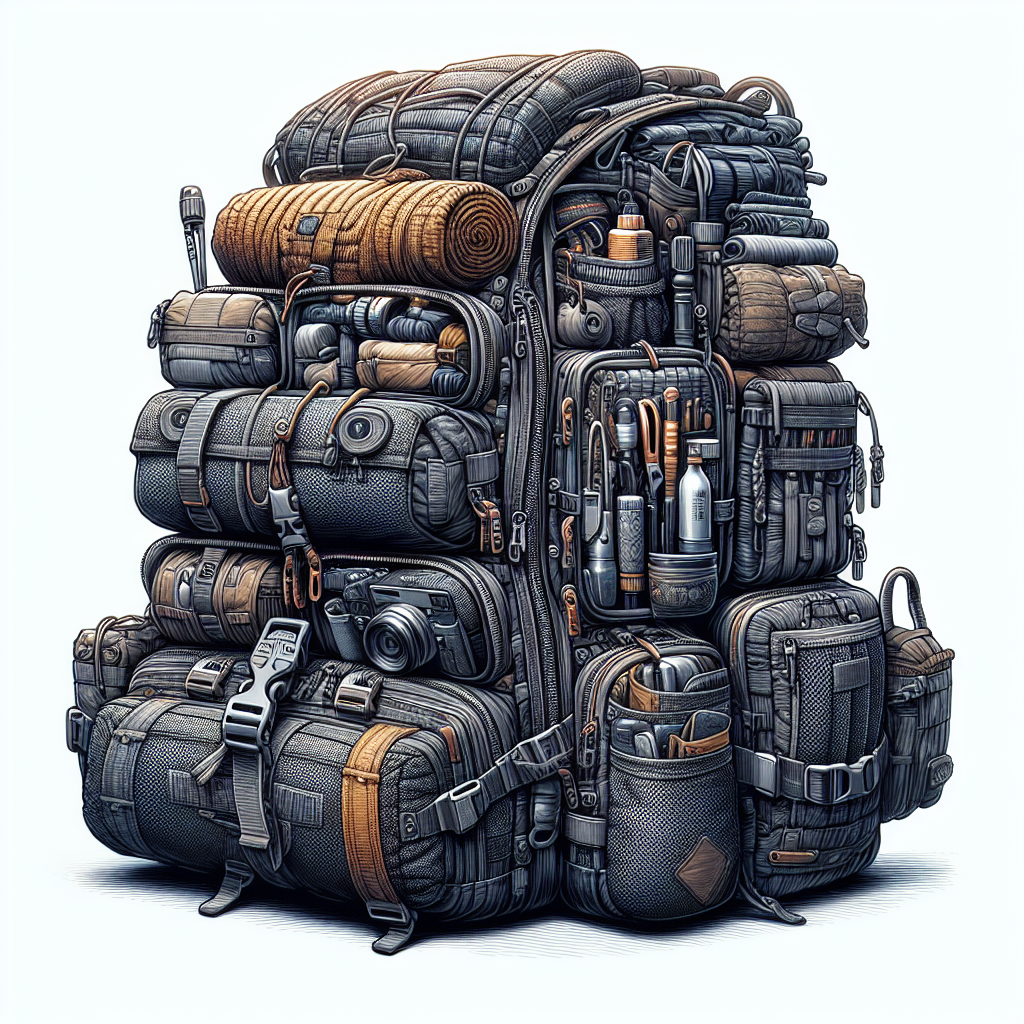How To Pack For A 2-3 Days Backpacking Trip

Heading out on a 2-3 days backpacking trip? Well, you’ve come to the right place! In this article, we’ll provide you with the ultimate guide of tips and tricks on how to pack for your adventure. Whether you’re heading out for a relaxing picnic, embarking on a thrilling cruise, or conquering the trails while hiking, we’ve got you covered. So, grab your backpack and get ready, because we’re about to make your packing process a breeze!
Choosing the Right Backpack
When preparing for a backpacking trip, one of the first things you need to consider is choosing the right backpack. The backpack you choose should be suitable for the trip duration, have the appropriate capacity, and possess essential features.
Consider the trip duration
The duration of your trip plays a crucial role in determining the size and type of backpack you should choose. For a 2-3 days backpacking trip, a smaller backpack with a capacity of around 30-50 liters will usually suffice. It’s important to choose a backpack that is not too large or too small for your needs.
Determine the capacity you need
The capacity of the backpack should be chosen based on the amount of gear and clothing you plan to carry. Consider the duration of the trip and the types of activities you’ll be engaging in. If you’re carrying a tent, sleeping bag, and larger camping gear, you may need a backpack with a greater capacity, around 50 liters or more. On the other hand, if you’re going for a more minimalist approach, a smaller backpack may be suitable.
Look for essential features
When choosing a backpack, look for essential features that will make your backpacking experience more convenient. Features such as multiple compartments and pockets can help with organization and easy access to your gear. Adjustable straps and a comfortable harness system are also important for a snug fit and even weight distribution. Additionally, consider features like a hydration bladder sleeve, built-in rain cover, and durable materials for added functionality and durability throughout your trip.
Clothing Essentials
Choosing the right clothing for your 2-3 days backpacking trip is essential for comfort and preparedness. Here are some tips to help you pack the right clothing items.
Check the weather forecast
Before packing your clothes, check the weather forecast for the duration of your trip. This will give you a better idea of the type of clothing you’ll need. Pack accordingly, whether it’s warm weather clothing, cold weather layers, or a mix of both.
Pack versatile clothing items
To make the most of limited space in your backpack, pack versatile clothing items that can be worn in multiple ways. Choose items that can be layered or mixed and matched to create different outfits. This will help you save space and ensure you have suitable clothing options for different weather conditions.
Consider layering options
Layering is key when it comes to outdoor activities. Bring a combination of base layers, insulating layers, and outer layers to accommodate for temperature fluctuations. This way, you can easily adjust your clothing to stay comfortable throughout the day.
Bring appropriate footwear
Don’t overlook the importance of appropriate footwear for your backpacking trip. Choose comfortable hiking boots or shoes that provide adequate support and traction. Make sure they are broken in before your trip to avoid discomfort or blisters.
Don’t forget swimwear and a towel
If your backpacking trip includes any water activities or opportunities for swimming, it’s important to pack swimwear and a lightweight towel. This will allow you to cool off and enjoy water-related activities during your journey.
Toiletries and Personal Care Items
Toiletries and personal care items are essential for maintaining hygiene and personal well-being during your backpacking trip. Here are some items you should include in your packing list.
Bring travel-sized toiletries
To save space and weight in your backpack, opt for travel-sized toiletries like toothpaste, shampoo, and soap. These mini sizes are convenient and practical for backpacking trips and will last you the duration of your journey.
Pack a lightweight towel or wipes
A lightweight towel or wipes are essential for staying clean and fresh on your backpacking trip. Choose a quick-drying and compact towel that takes up minimal space in your backpack. Alternatively, you can opt for biodegradable wipes that are easy to use and dispose of.
Carry a small first aid kit
Accidents can happen even on short backpacking trips, so it’s important to have a small first aid kit handy. Include items like band-aids, antiseptic ointment, pain relievers, and any specific medications you may need.
Include any necessary medications
If you have any ongoing medical conditions or require regular medication, make sure to pack an ample supply for the duration of your trip. It’s always better to be prepared and have extra medication in case of unexpected delays.
Don’t forget sunscreen and insect repellent
Protecting yourself from the sun and pesky insects is vital during outdoor activities. Pack a sunscreen with a high SPF for sun protection and an insect repellent to ward off mosquitoes and other bugs. Choose travel-sized versions or transfer them into smaller containers to save space in your backpack.
Sleeping Gear
Getting a good night’s sleep is crucial for an enjoyable backpacking trip. To ensure a comfortable and restful night, consider the following sleeping gear options.
Choose a suitable sleeping bag
Select a sleeping bag that is appropriate for the expected nighttime temperatures during your trip. Look for a bag with a temperature rating that matches the conditions you’ll be facing. A lightweight and compact sleeping bag is ideal for backpacking trips, as it takes up minimal space in your backpack.
Consider a lightweight sleeping pad or mat
A sleeping pad or mat provides insulation and cushioning between you and the ground. This is important for comfort, especially if you’ll be camping in rough terrain. Opt for a lightweight and compact sleeping pad or mat that offers sufficient insulation and support.
Pack a tent or hammock if necessary
If you’ll be camping outdoors, consider whether you’ll need a tent or hammock. A tent offers protection from the elements and privacy, while a hammock provides a lightweight and versatile sleeping option. Choose the option that suits your needs and pack it accordingly.
Kitchen and Cooking Essentials
When it comes to backpacking trips, proper nutrition is essential. Packing the right kitchen and cooking essentials will ensure you have the means to prepare meals and stay properly fueled throughout your journey.
Bring a lightweight camping stove and fuel
A lightweight camping stove is a great investment, allowing you to cook hot meals and boil water on your backpacking trip. Look for stoves that are compact and can be easily packed into your backpack. Don’t forget to bring enough fuel for the duration of your trip.
Pack cookware and utensils
Choose lightweight and compact cookware and utensils that won’t take up too much space in your backpack. Consider options like collapsible pots and pans, foldable utensils, and compact mess kits. These items will allow you to cook and eat your meals conveniently while saving space.
Carry food items with proper packaging
When selecting food items, opt for lightweight and non-perishable options that are easy to carry. Pack items in packaging that is durable and resealable to prevent any spillage or spoilage. Additionally, consider portioning meals ahead of time to save space and reduce food waste.
Include a water filter or purifying tablets
Access to clean drinking water is crucial during a backpacking trip. To ensure a safe and reliable water source, carry a water filter or purifying tablets. These tools will allow you to treat water from natural sources, such as rivers or streams, making it safe to consume.
Don’t forget a reusable water bottle
A reusable water bottle is a must-have item for any backpacking trip. It allows you to stay hydrated throughout the day and reduces waste from single-use plastic bottles. Choose a lightweight and durable water bottle that fits well in your backpack’s side pocket for easy access.
Navigation and Safety Tools
Being able to navigate and ensure your safety during a backpacking trip is essential. Here are some navigation and safety tools to consider packing.
Carry a detailed map or GPS device
Having a detailed map or a reliable GPS device is essential for navigation during your backpacking trip. Familiarize yourself with the route beforehand and have a backup navigation method in case of device failure. It’s important to know your surroundings and have a clear plan for each leg of your journey.
Include a compass or navigation app
In addition to a map or GPS device, bring a compass or use a navigation app on your smartphone. A compass can come in handy if you need to orient yourself or find your bearings. Downloading a reliable navigation app with offline capabilities can also be a useful tool when exploring unfamiliar areas.
Pack a headlamp or flashlight
A headlamp or flashlight is essential for navigating in low-light conditions or during nighttime activities. Choose a lightweight and durable option that provides sufficient brightness and has a long battery life. Don’t forget to pack spare batteries or ensure your headlamp is fully charged before your trip.
Don’t forget a whistle or signal mirror
Emergency situations can occur, and having tools to signal for help is important. Pack a whistle or a signal mirror to attract attention or alert others in case of an emergency. These small and lightweight items can be lifesaving in critical situations.
Bring a multi-tool and a fire starter
A multi-tool is a versatile and compact tool that can aid in various situations, from repairing gear to opening cans. Additionally, a fire starter, such as waterproof matches or a lighter, is essential for cooking, warmth, and emergency situations. These tools are small yet invaluable and should be included in your backpacking essentials.
Hydration and Water Management
Staying hydrated is crucial for any outdoor adventure, and managing your water supply properly is essential during a backpacking trip. Consider the following tips for hydration and water management.
Carry enough water for the trip
Calculating the amount of water you’ll need can be challenging, but it’s essential to carry enough for the duration of your trip. Depending on the availability of water sources along your route, aim to carry at least two liters of water per day. Adjust this amount based on the weather conditions and the intensity of your activities.
Consider water purification options
If you plan on relying on natural water sources, it’s important to have water purification options. Boiling water, using water filters, or purifying tablets can help remove harmful bacteria and ensure safe drinking water. Research and choose the method that best suits your needs and the available water sources.
Pack water storage containers or hydration bladders
Having suitable containers for carrying and storing water is critical. Choose lightweight and durable water storage containers or consider using hydration bladders that fit into your backpack’s hydration sleeve. These options allow you to drink water on the go and save space in your backpack.
Look for lightweight water filtration systems
In addition to carrying enough water, lightweight water filtration systems can be a useful alternative. These systems allow you to drink from natural sources, saving you from carrying excessive amounts of water. Look for lightweight options that provide efficient filtration without added bulk.
Plan for refilling water along the way
Research the available water sources along your planned route and plan for refilling your water supply. This may involve locating streams, rivers, or other reliable water sources. Always be cautious and consider the quality of the water before consuming or using it for cooking.
Food and Snacks
Proper nutrition is essential for maintaining energy and enjoying your backpacking trip. Here are some tips for planning and packing food and snacks for your 2-3 days journey.
Plan your meals in advance
To avoid any unnecessary weight and make meal preparation easier, plan your meals in advance. Consider the number of breakfasts, lunches, dinners, and snacks you’ll need and create a menu accordingly. This will help you pack the right amount of food and minimize waste.
Choose lightweight and non-perishable foods
When selecting foods, opt for lightweight options that won’t spoil easily. Dehydrated meals, instant rice or pasta, and trail mixes are great choices for backpacking trips. Choose items that require minimal cooking time and are easy to prepare with limited resources.
Pack high-energy snacks
To keep your energy levels up during the day, pack high-energy snacks like nuts, energy bars, or dried fruit. These snacks are lightweight, compact, and provide a quick boost of energy when needed. Consider packing them in portioned ziplock bags for easier access and portion control.
Consider freeze-dried meals
Freeze-dried meals are a convenient option for backpackers as they are lightweight, easy to prepare, and have a long shelf life. These meals only require boiling water to rehydrate, making them a popular choice for outdoor enthusiasts. They come in a variety of flavors and accommodate different dietary restrictions.
Don’t forget utensils and a lightweight stove
Ensure you have the necessary utensils for cooking and eating your meals. Pack lightweight and durable utensils like sporks or collapsible cutlery. Don’t forget to pack a lightweight stove if you plan on cooking hot meals during your trip.
Miscellaneous Gear and Accessories
In addition to the essentials, there are a few miscellaneous gear and accessories that can enhance your backpacking experience. Consider packing these items for added comfort and convenience.
Bring a lightweight backpack rain cover
Weather can be unpredictable, and rain is always a possibility. Carry a lightweight backpack rain cover to protect your gear from getting wet. These covers are compact and easy to slip over your backpack, ensuring your belongings stay dry during unexpected showers.
Pack a small tarp or groundsheet
Having a small tarp or groundsheet can be useful for various purposes during your trip. It can provide extra protection for your tent, a clean surface for gear organization, or a makeshift shelter in case of rain. Look for lightweight and waterproof options that can fold down to a small size.
Carry a cord or rope for various uses
A length of cord or rope comes in handy for various purposes during backpacking trips. You can use it for hanging up wet clothes, securing gear, or even setting up a small clothesline. Opt for a lightweight and durable cord that won’t add significant weight to your pack.
Include a small repair kit
Having a small repair kit can save the day if any gear or equipment becomes damaged during your trip. Pack essential items like duct tape, repair patches, a sewing kit, and any specific tools needed for your gear. These items can help fix minor issues and keep your gear functional.
Don’t forget a camera or binoculars
Capture the memories and enjoy the scenery by bringing a camera or binoculars. Whether you prefer photography or simply want to observe wildlife, these accessories can add an extra dimension to your backpacking experience. Choose lightweight options that won’t be a burden to carry.
Packing Tips and Techniques
Once you have all the necessary gear and essentials, how you pack your backpack can greatly impact your comfort and ease during the trip. Here are some packing tips and techniques to consider.
Organize your gear into separate compartments
Separate your gear into different compartments within your backpack to maintain organization and easy access. Use ziplock bags or packing cubes to group similar items together, such as clothing, toiletries, or cooking gear. This will help you locate specific items without having to rummage through your entire pack.
Use packing cubes or dry bags for clothing
Packing cubes or dry bags are excellent tools for compressing and organizing your clothing. Roll or fold your clothes and place them within the packing cubes or dry bags, removing excess air for a more compact pack. This method not only saves space but also helps keep your clothes clean and dry.
Place heavier items closer to your back
To improve weight distribution and balance, pack heavier items closer to your back and towards the middle of your backpack. This keeps the weight centered and prevents it from pulling you off balance. Lighter items can be placed towards the outside of your pack or in external pockets.
Pack items you may need during the day in accessible pockets
Consider the items you’ll need while on the move and pack them in easily accessible pockets or places within your backpack. This can include items like a water bottle, snacks, a map, or a camera. Having easy access to these essentials saves you from having to dig through your main compartment constantly.
Consider weight distribution and balance
Pay attention to weight distribution and balance when loading your backpack. Aim to distribute the weight evenly so that your pack feels balanced and won’t strain your body. Proper weight distribution helps prevent back pain and discomfort, allowing you to enjoy your backpacking trip to the fullest.
By following these comprehensive tips and techniques, you’ll be well-prepared for your 2-3 days backpacking trip. Remember to choose the right backpack, pack appropriate clothing, bring essential toiletries, ensure a comfortable sleeping arrangement, pack kitchen and cooking essentials, carry navigation and safety tools, manage hydration properly, plan your meals and snacks, pack miscellaneous gear and accessories, and employ effective packing techniques. With all the necessary preparations made, you’re ready to embark on an unforgettable adventure into the great outdoors!



